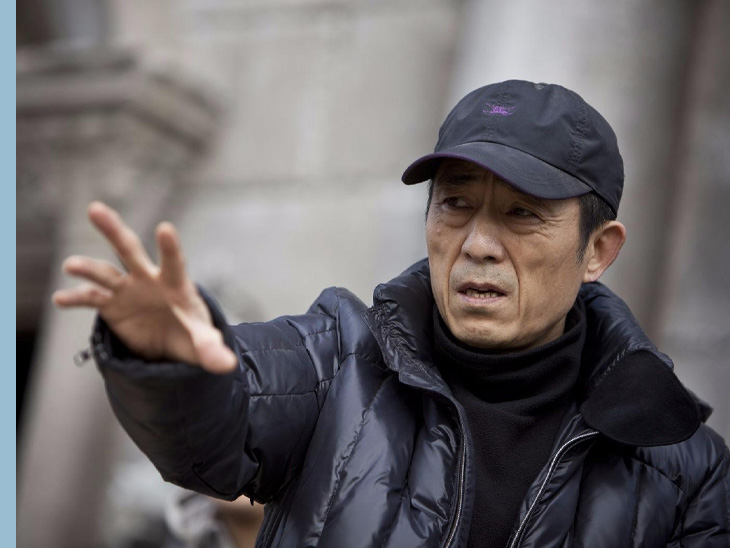VISUAL SPLENDOR
Unquestionably China’s best-known and most controversial filmmaker, Zhang Yimou (1951) introduced China’s cinema to the world with his distinctivefilming styles. He is most famous for his artistic films in thelate 1980s and the early 1990s and his martial arts films since 2004. The former cinematographer directed many beautiful intimate gems such as Red Sorghum, Raise the Red Lantern and Ju Dou, but also films of monumental beauty such as the stunning wuxia films House of Flying Daggers and Hero. Trained as a photographer, most of his film themes reflect some phenomena in ancient China. Zhang Yimou is undoubtedly the best marketing person in the Chinese film industry and he is also good at building his own brand. From the film photography techniques, Zhang Yimou has always been extremely demanding on composition, lighting, sense of picture and sense of story. The style has always been fixed, forming his own iconic style. Cinema, in Zhang’s view, has social responsibilities for giving voice to underprivileged groups, or at least providing a narration to their experiences. His films at this stage reflect the particular cinematic and literary interests inrural China.
Now that his recent film, One Second, about a movie fan in a remote farmland strikes a relationship with a homeless female vagabond — do I notice a nod to the Italian film Nuovo Cinema Paradiso? — has also been screened in our cinemas, I thought it was opportune to tell a story about this film director with an impressive record. Can a film be too beautiful? Zhang’s signature as a filmmaker in his early films was to balance spectacular beauty and thematic weight. The director once said that “good films should first be attractive” and that second they “should say something of substance.”
EXUBERANT ASIAN CINEMATOGRAPHY
I was 23 years old when I first saw a film by Zhang Yimou in the cinema and it made a huge impression on me. I had just left art school and graduated as a graphic designer when I first saw Raise the Red Lantern (1991). The sophisticated color palettes full of symbolism, the dazzling choreographies and the astonishing interplay of image, rhythm, costume, sound and setting approached perfection. In short, the whole atmosphere was an overwhelming spectacle and prompted me to discover more Asian films. Soon after, I saw Red Sorghum (1988) — known in Belgium as Het Rode Korenveld (The Red Cornfield) — which definitely impressed me too.
These films have influenced my future cinema-going behavior, leaving me with gems from directors Wong Kar-Wai (In the Mood for Love and My Blueberry Nights), Andrew Lau Wai-Keung (Infernal Affairs), Ang Lee (Eat Drink Man Woman and Crouching Tiger, Hidden Dragon) and Kim Ki-duk (Bin-jip and Spring, Summer, Autumn, Winter ... and Spring) among many others. Since then I was curious about Eastern films in general and I also decided to travel through different countries in Asia, but strangely enough I have never been to China (yet).
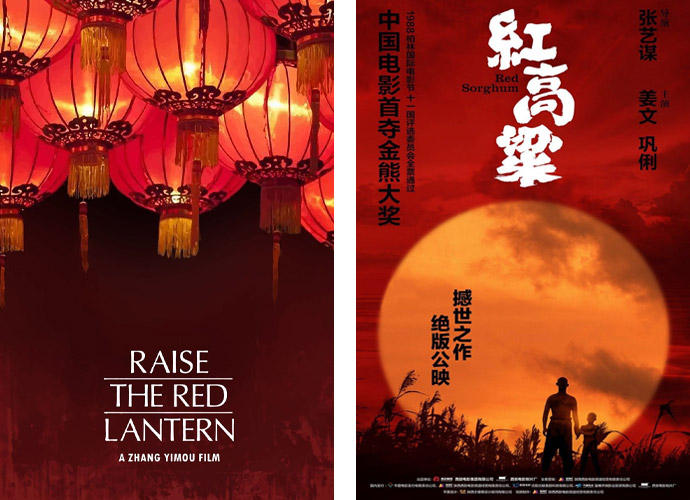
Red is an essential color in several Zhang Yimou's films, from the titular Red Sorghum to the red silk in Ju Dou, from red lanterns to Gong Li’s red coat in The Story of Qiu Ju (1992), and her red dress in Shanghai Triad (1995). It is the most prominent color symbol in Chinese culture, appearing in the red sun, red flags, red envelopes, red guards, and red dragons. Zhang employs a traditional strategy for the color red, but he also uses it in rebellious terms. For instance, the red lanterns lit all day as symbols of longevity could represent the patriarch’s sexual control over his wives. They also suggest the desire and victory in the competition among the other mistresses. The red †encourages unrestrained lust for life,” according to Zhang.
During the Cultural Revolution of the 1960s and 1970s, Zhang was forced to leave school at a young age after his father, who fought against the Communists during the country’s civil war, was branded a counterrevolutionary. He first found work as a farm labourer for three years, then in the Shaanxi Cotton No. 8 Factory — a cotton textile mill — for seven years, all the while dabbling in art and photography. Zhang sold his blood to buy his first camera. His interest in photography allowed him to take, among other things, the wedding photos of his friend and roommate and his wife when they got married. The wedding photo was a backlit landscape photo. Mr. Hao and his lover sat under a large tree with their backs to the camera. It was shaped like a cut in paper, but also like a sketch, full of charm. A very special wedding photo, especially at that time. Zhang Yimou's ability to capture the wedding photo that way indicated that he had a unique talent.
In the factory, Zhang Yimou was a very hardworking and tenacious person and soon he was transferred to the hosiery workshop to design socks for 4 years. So Zhang was not only involved in photography, but also in visual graphic design. He was considered too old for admission by the time the Department of Photography of the Beijing Film Academy reopened after China’s Cultural Revolution. But Zhang persisted and in 1978 he was admitted on the strength of his photography portfolio. Stories circulate that Zhang Yimou took great care in shooting and developing photos to produce good photographic works. At the time, he was not satisfied with using the ready-to-use developer and fixer solution to develop the ideal photos. He designed many formulas himself and prepared the pharmaceutical solution according to different situations.
After graduating in 1982, he was assigned to Guangxi Film Studio where he served as a photographer for the first time in the movie One and Eight in 1984 and won the China Film Excellent Photographer Award. Two years after graduating, Zhang Yimou surprised the film world with his rock-solid debut film Red Sorghum, which won the Golden Bear in Berlin. It became the first of many milestones for Chinese cinema that Zhang would achieve in the following years.
Seen by many as one of the giants of Chinese cinema and included within the 5th Generation of filmmakers, Zhang Yimou is revered the world over for his highly distinct style. Starting his career as a bit of a rebel who made independent films that enraged the ruling Communist Party, he wisely realised that if you want longevity within China as an artist you must secure the support of the government. Hence his very lucrative latter career was spent making Wuxia action films.
With a background as a cinematographer, it’s no surprise that Zhang’s films have such a powerful visual presence and so many of the shots look like paintings, exquisitely accomplished. He frames his images with natural lighting and a philosophical approach to space, shot through with a bold approach to colour, as we’ve already seen. These are elements that define key aspects of China’s different painting schools, through the centuries and various dynasties. The photography in Zhang’s Wuxia films and in his low-key dramas follow these age-old techniques.
"The Cultural Revolution was a very special period of Chinese history, unique in the world. It was part of my youth. It happened between when I was 16 and when I was 26. During those 10 years, I witnessed so many terrible and tragic things. For many years, I have wanted to make movies about that period — to discuss the suffering and to talk about fate and human relationships in a world which people couldn't control and which was very hostile. I would like to make not just one but many movies, both autobiographical and drawing on other people's stories." — Zhang Yimou
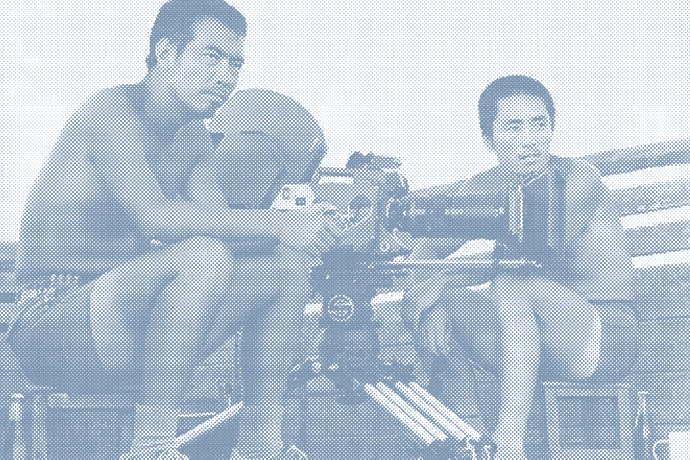
Chén Kaigē and Zhang Yimou who were filming Yellow Earth.
THE FIFTH GENERATION
Although films released before the Communist takeover in 1949 were varied and often contained humanist themes, the Party closely monitored films as products of socialist reconstruction. Chinese filmmakers learned their craft and techniques from predominantly Russian instructors resulting in predominantly social realist films. After the Cultural Revolution in 1966, the state brought film production to a veritable standstill until 1976. Films were foremost propaganda concerned with controlling how Chinese people thought and how the country was viewed by international audiences.
Following Mao’s death, the Beijing Film Academy reopened and gave its first new round of graduates, including Zhang Yimou and Chén Kaigē, an opportunity to examine social problems with a freedom new to Chinese filmmakers in what came to be known as the Fifth Generation. The First Generation spans from the silent era to the Japanese invasion of China in 1937; the Second Generation takes place during the war years, including the resistance against Japan and the Civil War; the Third Generation picks up after the Second World War, during the Communist takeover in 1949; the Fourth Generation was limited to the short period between Mao’s death and the reopening of the Beijing Film Academy. Although Zhang would become the most well-known of all Chinese filmmakers, Zhang Junzhao’s One and Eight (1983) and Chen’s Yellow Earth (1984) — which tells a story of an army soldier who goes to a remote village in search of folk songs — were the first two films of the Fifth Generation; they were also Zhang’s first two assignments during his early career as a cinematographer. Finally, the new filmmakers who emerged in China until the Tiananmen Square massacre in 1989 were followed by the Sixth Generation, which continues today.
The Fifth Generation filmmakers were encouraged by Deng’s government to critique the Cultural Revolution and explore the country’s history. Graduates learned how theme, color, objects, landscapes, and historical periods could strengthen the symbolic potential of their craft, moving film art away from the rigid realism of the Soviet style embraced in the past. At once, their films captured the attention of Western viewers unfamiliar or previously uninterested in Chinese cinema, and they were recognized by the authoritarian government for their criticisms of the regime.
Zhang Yimou built a reputation in the global community with his stunning imagery and accessible narratives, but his films put him at odds with the Chinese censors. His directorial debut, Red Sorghum, earned several international awards, including the Golden Bear at the Berlin Film Festival.
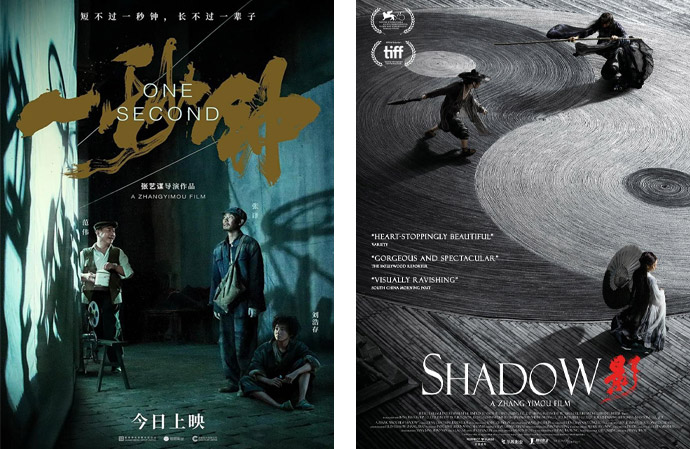
BIG BREAKTHROUGH
Filmmaker Zhang Yimou has made some of the most visually stunning films I’ve seen. Hos journey to becoming one of China’s leading directors has been filled with unusual, often dramatic twists. His films have won prizes at the Cannes Film Festival, the Venice Film Festival, and the Berlin International Film Festival, and six of his films have been nominated for Academy Awards. I'm certainly not going to go into detail about all of his films I've seen. I'll limit myself to the first ones that influenced my view of visual culture. That means that I will not mention masterpieces such as The Story of Qiu Ju, The Road Home, Not One Less, To Live, Hero, House of Flying Daggers (although one of my all time favorites) and Coming Home, but if I have triggered you in one way or another, be sure to be surprised by these extraordinary wonderful movies!
Ju Dou (1990) is the big breakthrough of Chinese filmmaker Zhang Yimou. It's his third film. The title role is played by Gong Li, discovered by Zhang Yimou and she was also Zhang's life partner for a long time. She has tremendous talent and was one of the most celebrated actresses from China in the 90s. In addition to the beautiful acting of the actors, the film itself is also a visual spectacle. The framing and use of color are very special. Zhang Yimou uses the fabric weaving mill as a starting point. This setting provides bold colours as part of the visual language of the film, and the colourful dyed cloths fall and fold as the story ’unfolds’. The story can be regarded as a film noir, but Zhang uses bright colors as a counterpart to the melodramatic story. It's a beautiful dramatic spectacle about honour, guilt and traditions in the Chinese countryside.
Ju Dou is an artistically filmed story of a beautiful young woman named Ju Dou who is forced against her will to marry the aging owner of a dye factory to provide for posterity. The elderly husband beats her ferociously when she fails to become pregnant. She then falls in love with her husband’s adopted son. They bear a child, setting in motion events that lead to tragedy.
It was also the first Chinese film to be nominated for an Academy Award for Best Foreign Language Film, in 1990 at the 43rd Cannes Film Festival. The story of adultery and revenge set in the 1920s, the film’s strong sexual themes, bleak depiction of rural life and morbid ending may all have played a role in provoking Chinese authorities’ anger. The tale also can be viewed as a metaphor reflecting on the fate of China itself, which then was controlled by a tiny clique of old men headed by Deng Xiaoping.
Therefore, the Chinese government blocked it from general release and sought to withdraw the film, a request that the Academy of Motion Picture Arts and Sciences rejected. Ju Dou lost out as best foreign-language film to the Swiss work, Journey of Hope. The film was banned for a few years in China. In a turn sometimes perceived as a bow to pressure resulting from Zhang’s growing international celebrity, the government reversed their ban in July 1992. Zhang Yimou apparently has not suffered any punishment for the Academy Awards controversy.
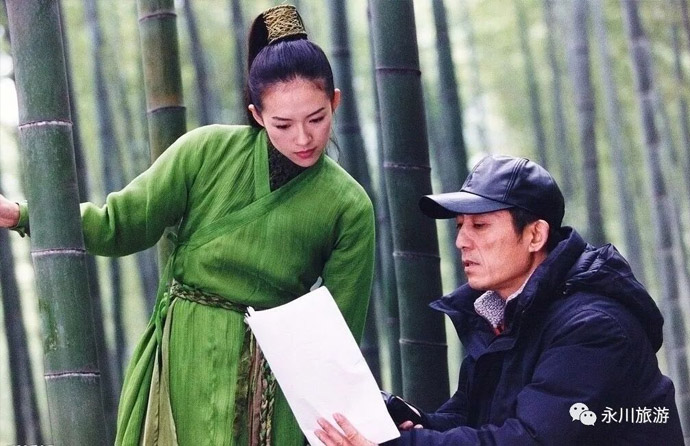
Zhang Yimou directs Zhang Ziyi as a blind warrior on the set of the historical epic House of Flying Daggers.
"All the current Chinese films that the state supports are based on collective values of unity and placing the common welfare above oneself. Ju Dou fights this kind of thinking. We cannot make films like Ju Dou anymore. The government is not afraid of one knife. But it is afraid of a big wave." — Zhang Yimou
Raise the Red Lantern, shot on location inside a centuries-old walled gentry mansion in Shanxi Province, is another story set in the pre-World War II period involving adultery by a woman married to an older man. Set in the 1920s, the film tells the story of a young woman who becomes one of the concubines of a wealthy man during the Warlord Era. It is noted for its opulent visuals and sumptuous use of colours. Raise the Red Lantern goes beyond attractive and provides an entrenched visual schema, where form follows function to staggering heights. Although the screenplay was approved by Chinese censors, the film portrays a complex system of social and gender power structures. China’s regimented population planning measures and cultural inequalities for women reflect an enduring ideology that values male lives over female lives. Zhang's critique didn't go unnoticed, which led to China briefly banning Raise the Red Lantern for a period.
Raise the Red Lantern tells the story of a young college girl, Songlian, who is forced to become the fourth concubine of an old merchant by her stepmother after her father’s death, and how she manages to survive the scheming and backstabbing melee of wives and maids living under strict and highly traditional patriarchal rituals. The film depicts her life in the dark courtyard as wholly marked by loneliness, sorrow and despair.
The story that Zhang Yimou tells is intriguing enough in itself, but he puts his qualities as a cameraman in it through another fabulous use of colors and a style that seamlessly covers the strict discipline in the mansion's courtyard. This tightness and rigidity of the rules and rituals of the house makes Zhang visible and palpable in his camera angles and the rhythm of the editing.
The title of this movie indicates a family ritual to signal the husband’s sexual predilection and the illuminating red lantern, representing the hope and festivity in Chinese tradition, becomes a symbol of the suppressed life confined in the deep courtyard. The traditional courtyard, which is often filled with live activities and children, becomes a place enveloped with darkness and represents the closeness of the feudal society and the impasse of astagnant life. Songlian and other wives and maids are stonewalled in this cruel and cold courtyard and, in different ways, they all become victims of family politics of power and control. Zhang deliberately constructs a narrative from each woman to reveal their sorrows and oppression. The film is thus a continuation of his themes on women and feudalistic oppression.
Zhang displays a full command of filmmaking technique in this film with his characteristic lighting and camera angles, especially his use of red lanterns, which, when contrasted to the dark-grey brick house and its rooftops, provides a detailed visual metaphor for the feudalistic ritual and the plight of women. The film is also pointedly claustrophobic, unfolding entirely within the compound aside from a single scene early on of Songlian on the road to her new life. Each visual choice works in unison with the film’s meaning.
The film also became a huge success abroad and remains among Zhang’s most celebrated and decorated works, having won the Silver Lion at the Venice International Film Festival and many other prestigious prizes. Even so, the film did not play well in China.
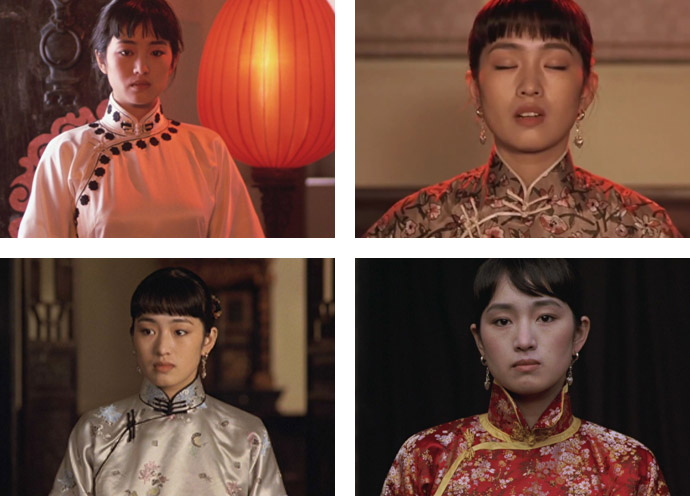
Who doesn't remember the classy images of Gong Li in Raise the Red Lantern, where the Chinese actress wore stunning and colorful costumes? Because of all these wonderful films I have to admit that I find the cheongsam, also known as the qipao, a very elegant figure-fitting Chinese dress. The long-standing elegance and serenity of it makes wearers fascinating and elegant. Also remember when Maggie Cheung enraptured audiences with her colorful cheongsams in The Mood for Love. That movie is definitely worth a story too!.
"What I want to express is the Chinese people’s oppression and confinement, which has been going on for thousands of years. Women express this more clearly on their bodies because they bear a heavier burden than men." — Zhang Yimou
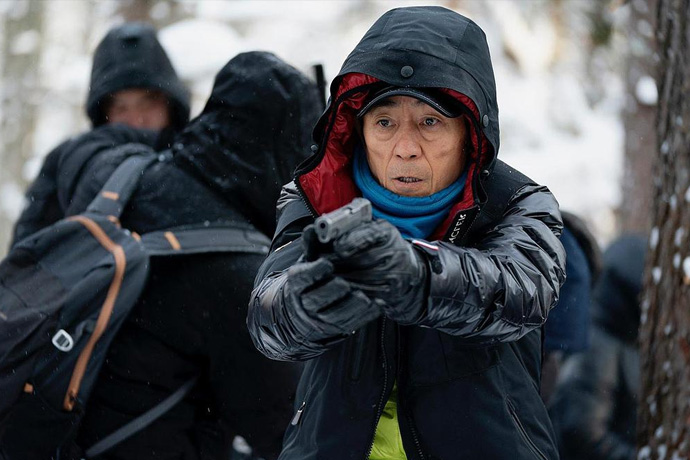
ARTISTRY AND COMMERCIALISM
In 1994 the Chinese government decided to import ten big-hit Hollywood films each year. As the Chinese audience became increasingly exposed to Hollywood films with big stars, big budgets and thrilling stories, Chinese filmmakers felt the pressure to seek for new directions for Chinese cinema. For Zhang, the way to save the Chinese film industry was to create films that would seek to entertain rather than only educate the audience. His previous films had brought him international festival and academic recognition but had not transformed into profit and market returns. For him, filmmaking had ceased to be about ‘art’ as a pure subject but rather about box office and the financialrevenue that films bring in. This new direction has unsurprisingly brought Zhang accusations of compromising and complying with the Hollywoodfilm model of pure entertainment and consumerism.
To break away from the earlygenres of his artistic flms, Zhang made several attempts to produce commercial entertaining movies in the mid-1990s. The international success of Ang Lee’s Crouching Tiger, Hidden Dragon (2000) gave Chinese filmmakers an answer in their search for the a genre of films. Its award-winning performances at the Academy Awards and the Golden Globes indicated to Chinese directors that there was, and still is, a increasing interest in martial arts movies in the West which had first seen popularity in the 1970s with the work of Bruce Lee. And let that just be the martial arts actor I first went to the cinema for.
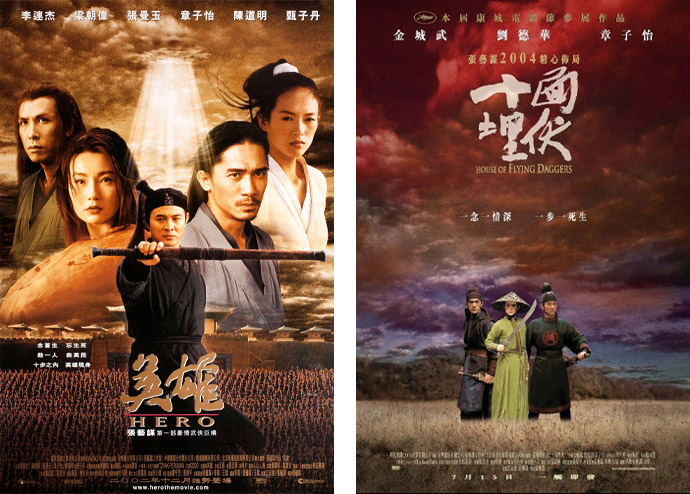
With his second martial arts film House of Flying Daggers (2004), Zhang Yimou proves to master the craft, in his own way. He just lets the action of grandmaster King Hu and the love lyricism of that other grandmaster Wong Karwai merge, to tingle all the senses. House of Flying Daggers is not the hardboiled Chinese sword fighting movie, referred to as wuxia-pian, that Zhang Yimou himself grew up with. He clearly adds his own lyricism and tragedy to the action, and that makes the film heartbreakingly beautiful. It is a triumphant play with images and sounds in which deceit predominates. The deception is also in the three characters, in Chinese actress Zhang Ziyi — already present in Ang Lee's Crouching Tiger, Hidden Dragon (2000) and Zhang Yimou's Hero (2002), two martial arts films that House of Flying Daggers gleefully builds on — as the girl Mei, in Japanese actor Takeshi Kaneshiro as the womanizing Jin and in Hong Kong actor Andy Lau as army captain Leo. They lie and cheat a lot, and if you think you know what's up, Zhang Yimou has a new surprise in store.
Zhang Yimou pushed the boundaries of domestic film, but after experiencing the foreshadowing of Shadow (2018) and One Second (2020), Zhang Yimou eventually settles into a commercial Chinese historical spy thriller film with Cliff Walkers (On the Cliff). Meanwhile, Zhang also made an urban crime drama Under the Light and a war film Snipers, a story of a young army sharpshooter recruit who at age 22 sets a record during the Korean War by reportedly killing or wounding 214 American soldiers with 435 shots in just 32 days. The film was originally named The Coldest Gun. The title, full of texture, rigidity and artistic beauty, was widely acclaimed, but when the launch was announced, it was renamed Snipers. Released on the eve of the founding of the army, this movie will be the best test of Zhang Yimou's current box office appeal.
In an interview, he let slip that he might also make a science fiction film in the future. Zhang Yimou was admired by thousands of people in the era of literary films. Its transformation into commercial films was criticized by the public, but led to Chinese commercial blockbusters. He also wants to push the boundaries of Chinese commercial films. I can only hope that these recent films will soon hit our screens in the near future!
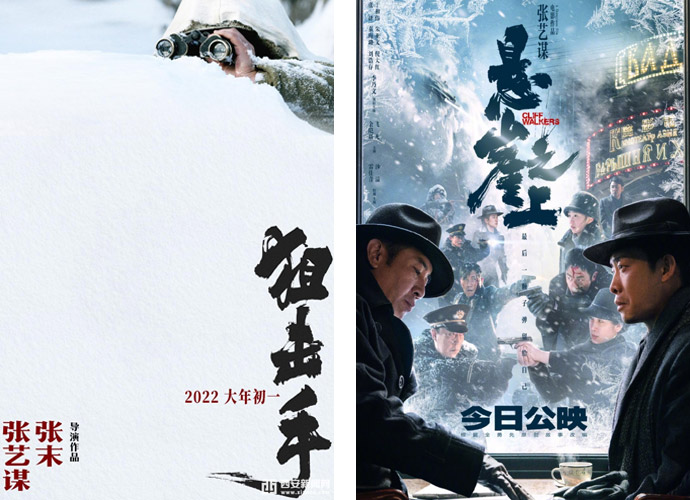
Left: Snipers tells the ostensibly true story of a sniper battle during the Korean War, when sharpshooter Liu Wenwu, aka Grim Reaper, is targeted by the Americans — for capture, inexplicably. A company of well-equipped veteran snipers bait Liu and his scrappy yet accurate company of young snipers with the half-dead body of their friend. A standoff ensues, with our heroes in a trench aiming at the Americans’ fortified hilltop and making ample use of their one pair of binoculars.
Right: Zhang Yimou makes a chilling, propagandistic and complex chess piece about double agents. Virtuoso craftsmanship that, after political censorship, should put him back in the spotlight with the Chinese government. In 2019, Zhang Yimou's One Second was withdrawn from the Berlin Film Festival by the Chinese government. There were technical problems, although suspicions of political censorship seemed more plausible. Zhang then returns with the bloodcurdling propaganda film Cliff Walkers. Four special agents are dropped during a snowstorm in the Japanese-occupied Manchukuo province. Their goal? Rescue Chinese comrades and investigating inhumane experiments. Labyrinthine chase scenes follow icy clashes between double agents at a fast pace. Zhang pulls out all the stops to deliver an exciting and virtuosoly filmed spy thriller.
All images courtesy of the artist.
More story related movies/interviews:
Related stories on Woodland:
Sources:
